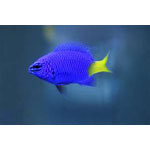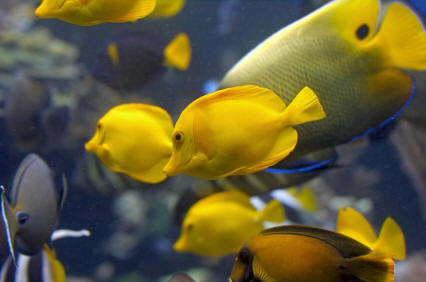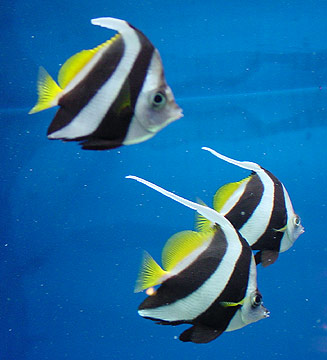Yellow Tail Blue Damsel

|
Scientific Name: Chrysiptera parasema Price: Upon Request Origin: Indo-Pacific Family: Pomacentridae NOT AVAILABLE NOW |
|
Other Names: Yellowtail Damsel , Blue Yellowtail Damselfish, Goldtail Demoiselle, Yellowtail Demoiselle |
|
Technical Info
Temperature: 22 - 26 ℃
pH: 8.1 - 8.4
GH: 8 - 12
SG: 1.020 - 1.025
Max size: 8 cm
Min Tank size: 110 Ltr
Position in Aqua: Top swimmer
Description
The Yellow Tail Blue DamseLl is extremely hardy and gorgeously colored. In fact, Chrysiptera parasema is considered by many aquarists, both beginning and advanced, to be the ultimate damselfish. This is partly because its jewel-blue body is contrasted by an energizing yellow tail. This color combination looks stunning against any backdrop of corals and live rock.
Food
The Yellow Tail Blue Damsel is not a finicky eater in the aquarium and will accept virtually all kinds of food, including flakes. Keep it on a varied omnivore diet to ensure optimal health. You can for instance use high-quality flakes or small pellets as a base and supplement with live, fresh or frozen meaty foods and vegetables, e.g. roman lettuce. Plankton and algae in the diet is known to be beneficial.
Breeding
It is difficult to sex Yellowtail Damsels based on outer appearance. The Yellowtail Damsels is an egg-laying species. It has been bred in aquaria, but the offspring is hard to rare. The fry will often die 2-3 days after being hatched. It is important to provide them with food small enough for them to eat and keep the water quality really high. They need really tiny food, e.g. paramecium (a type of unicellular ciliate protozoa).
Compatible with
Avoid keeping them in an aquarium with Lionfish, Snappers, Groupers, Triggers, Eels or any other predatory fish large enough to eat them.
Note
It is sometimes confused with its close relative the Azure Damsel (Chrysiptera hemicyanea), but the Azure Damsel has more yellow on its body than the Yellowtail Damsel. In an Azur Damselfish, the yellow colour is primarily found in the pectoral and anal fins and not in the tail.

